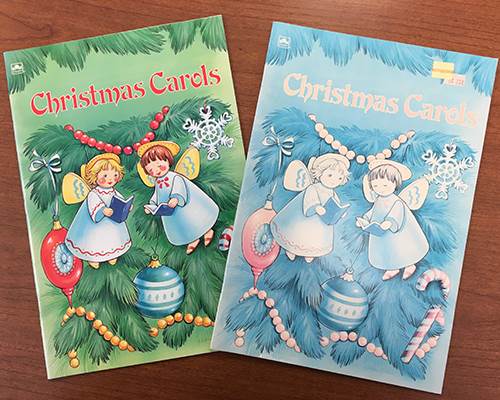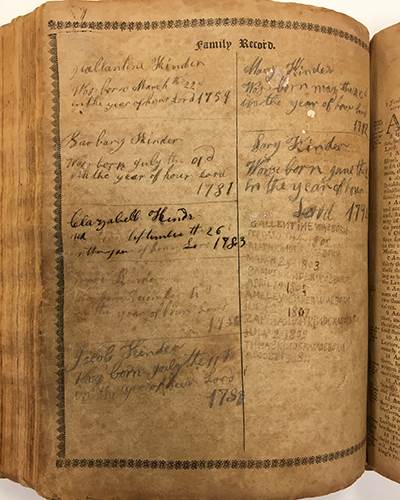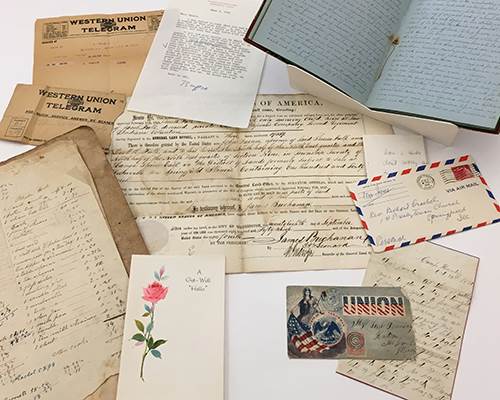By Bonnie Parr
Do you have a family Bible or an old journal that records the births, marriages, and deaths of your ancestors? Letters written by your grandparents that provide insights into daily life of an earlier era? Photographs of your family and relatives spanning the generations? We can help you create the proper environment to ensure the long-term preservation of these precious family history mementos.
Providing a good environment for storage and display is absolutely crucial to preserving historical materials. This is because books, documents, and photographs are made of organic materials and are very reactive to their surrounding conditions. They readily absorb acids and become acidic from dust and air pollutants. The combination of heat and moisture accelerates chemical reactions and encourages mold growth and insect activity. Conditions that are too dry cause brittleness in paper, dry out adhesives on book spines, and crack, peel, or curl photographs. Exposure to light causes irreversible fading, yellowing, or darkening of paper, inks, and photographs.
 An example of damage from exposure to light (Bonnie Parr)
An example of damage from exposure to light (Bonnie Parr)
A proper environment for preservation is one that is CLEAN, COOL, DRY, AND DARK. Here are tips for providing an environment that preserves your family history materials – actions that also won’t break your budget.
Maintain a clean environment where your family history materials are stored or displayed.
Practice good housekeeping with a regular schedule of cleaning, replacing air filters, dusting, and vacuuming in storage and display areas.
Keep collections away from the vicinity of food and beverages, open windows, and sources of atmospheric pollutants (such as cleaning products, paint, car exhaust, and sources of smoke).
Periodically inspect for insects and mold growth. Use non-chemical methods to eradicate problems, including finding and sealing areas of pest access, cleaning regularly, and improving air circulation. Avoid using chemicals (insect repellant, antiseptic or cleaning sprays) on or near historical materials. Chemicals are readily absorbed into paper, can cause staining, and accelerate deterioration. Accumulated chemical residues pose a health hazard.
Keep collections off the floor, so they are less likely to be accessed and damaged by pests or to get wet.
Keep storage and display areas cool and dry.
Temperature and humidity must be moderate and controlled as much as possible. Aim for low 70’s°F (or cooler) and around 50% relative humidity. However, controlling fluctuations in temperature and humidity is more important than adherence to a specific degree of temperature or percentage of humidity. Fluctuating conditions cause structural damage as paper-based items expand and contract in response to changes.
 The ravages of age on a family Bible (Abraham Lincoln Presidential Library and Museum)
The ravages of age on a family Bible (Abraham Lincoln Presidential Library and Museum)
Avoid storing historical materials in attics, basements, or garages – areas that typically have extreme temperature and humidity conditions (unless these areas are climate controlled). Also avoid storage or display against exterior walls which are impacted by humidity changes related to weather conditions.
Choose storage and display in rooms with interior walls on the main floor – a space that generally has a more stable environment.
Make sure storage and display areas are away from sources of heat and water (such as fireplaces, air vents, windows and sinks).
Allow for good air circulation. This is necessary to maintain control of temperature and humidity and prevent accumulation of outgassing or chemical deterioration products. Leave a few inches of space between the wall and shelves or storage cabinets. Also, leave space between the wall and stored items.
Keep collections in the dark (or mostly in the dark).
Ideally, choose storage and display spaces with no windows and where lights are normally kept turned off. If there are windows, use curtains or shades to prevent sunlight from shining directly on historical items.
Minimize exposure to ANY type of light. Items with color media are especially sensitive to light and can fade quickly. Limit the amount of time and intensity of light by turning lights off when not needed and using lower wattage light sources where possible.
Use UV (ultra-violet) filtered glass or acrylic on framed items. This type of glazing blocks ultra-violet light – the most damaging range of light energy. However, UV filtered glazing will not prevent damage caused by exposure to visible light.
 Many types of documents can be precious to your family. (Abraham Lincoln Presidential Library and Museum)
Many types of documents can be precious to your family. (Abraham Lincoln Presidential Library and Museum)
Avoid displaying items on a permanent basis. Ideally, change displays every six months or so to allow items to “rest” in dark storage. Consider using reproductions for display instead of originals.
Monitor the condition of displayed items to detect fading, yellowing, or image changes.
By carefully considering the environment in storage and display spaces, you will be taking significant action to preserve your family history materials for future generations.
Bonnie Parr is the ALPLM Historical Documents Conservator.